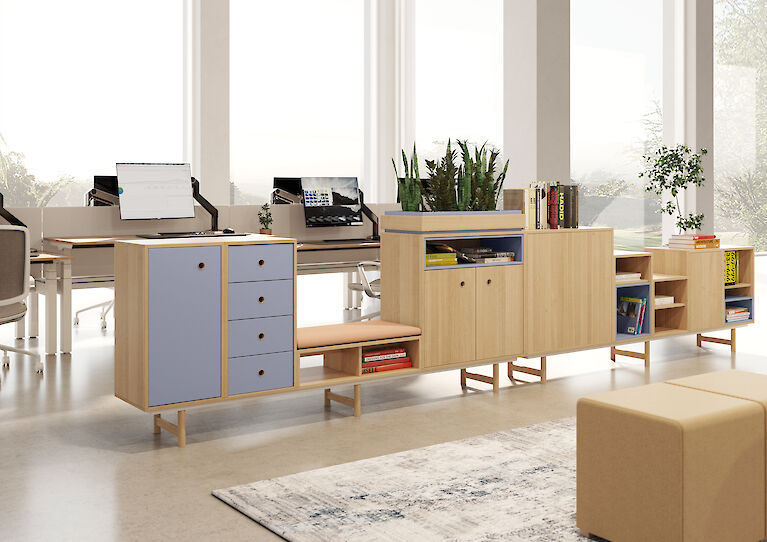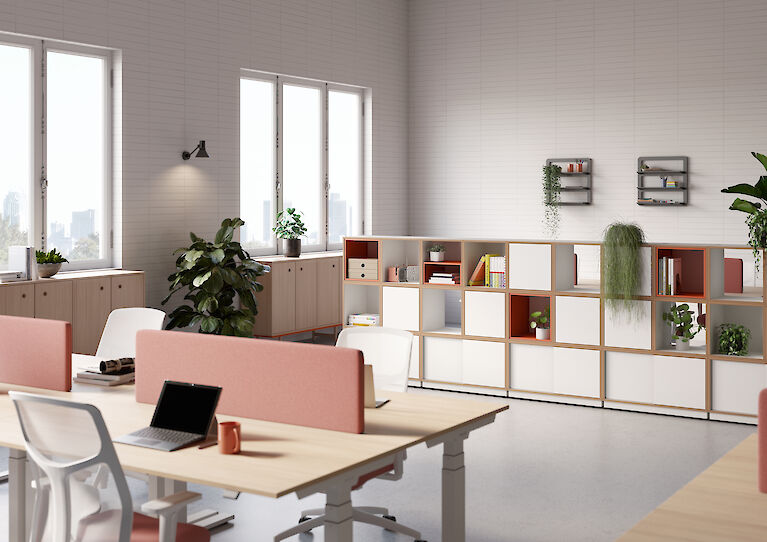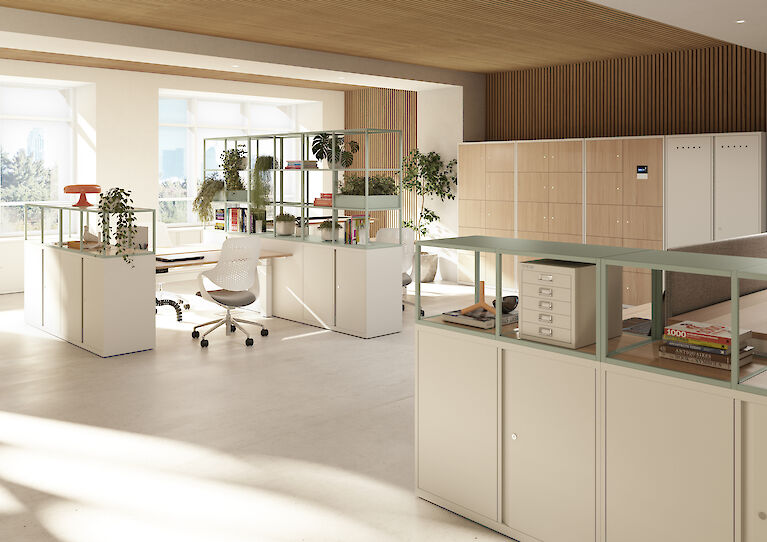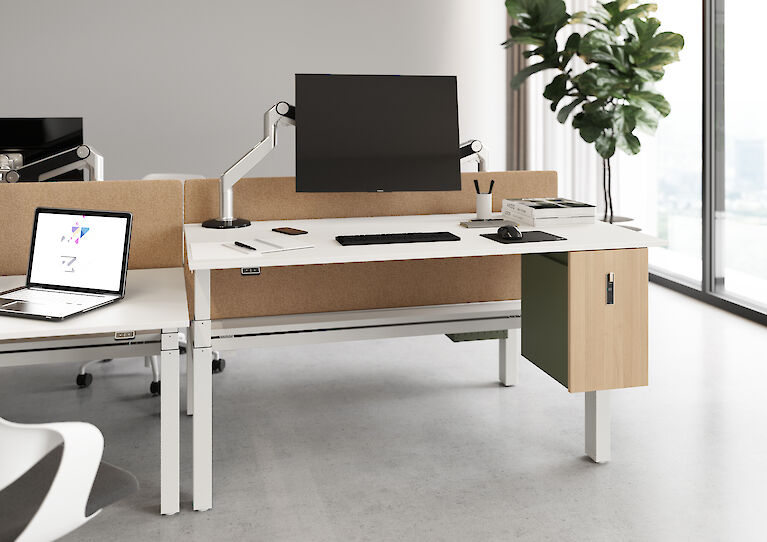Post-pandemic, the way many of our workspaces now look and operate have changed dramatically, with office time combining a mix of in-person meetings, or agile, collaborative spaces to work.
With employee wellbeing being a firm focus when it comes to retaining workforces and keeping morale high - in addition to boosting and growing businesses - we’re seeing the same question being asked – how can we ensure that our workspaces are furnished to boost not only employee wellbeing, but also to provide a sense of comfort and ease, and ensuring that it’s set up for interaction with others?
Here are some considerations you’ll need to make.
Colour
Colour is used widely to enhance and improve our experience of wellness, allowing us to connect physically and mentally with our bodies and mind. However, different colours can be used for different experiences, depending on a space’s aims and functions.
Pastels and neutrals have gained popularity recently and we’re seeing these shades being used across everything, from clothes and beauty products, to home accessories and office design. Shades such as browns, creams, and lavenders provide a tranquil, relaxing, and calm environment, allowing employees to complete tasks that require more thought and concentration.
On the other hand, bold colours such as yellows and oranges are great ways to brighten up a workspace. Used predominantly to enhance and inspire, these shades are perfect for creative and collaborative sessions where new ideas can flourish.
Take the time to consider your space and what you’d like it to deliver. You should also ensure that the colours used throughout your workspace reflects your brand and personality.

Agile work systems
Agility, adaptability and flexibility are all working systems that employees are now seeking. So, what does this mean for businesses? The furniture you choose should have multiple functions as well as flexibility.
The office landscape continues to change and adapt, and workspaces and the furniture chosen must reflect this. Our products, such as Be and Bridge are inspired by the need for a versatile and open working environment. Furniture can create adaptable zones that foster collaboration and provide areas to meet, individual space to focus, and space to relax and recharge.
You should also consider the surfaces that are on offer – are you able to provide sit/stand desks to accommodate varying working heights, or can desks can folded or stacked to allow more floor space? Providing your people with the decision-making power will give them the choice to decide how best to work, meaning a happier and more diverse workforce.
Spaces should be informal and welcoming
Most of us are social beings and enjoy the company of others, which is one of the major reasons many of us do return to the office.
Offering flexible and informal solutions to host these collaborative sessions, catch ups, and conversations is vital in ensuring employees keep returning and enjoy spending time in the office. Peppered common areas throughout the workspace are great ways to encourage spontaneous conversations and gatherings, enhanced by enveloping shapes and neighbourhoods.
We also work better when we feel calm and relaxed so providing different textures and furnishings is a great way to bring the feeling of home into the office, boosting productivity and creativity even more!

Storage for belongings
One of the important considerations when designing your workspace is how you’ll incorporate the storage you need without compromising style.
Having storage options allows you to keep your desk clutter-free and organised which in turn, boosts focus and concentration levels. Employees can also store personal equipment securely which is great, especially for after work activities.
Storage is also multifunctional and can be used to zone the office. If you’re looking to create dedicated areas for quiet working, spaces for collaborative sessions, or even zones to meet and catch up, large storage units can be great for this as it creates a degree of privacy and sound dampening qualities. This is also a great cost-saving exercise as it allows you to truly transform the space without building walls.
A quiet corner
While many employees will come to the office to work and meet other colleagues, throughout the working day, it is important to have the opportunity to seek a quiet nook or corner to work privately and quietly. These spaces that promote concentration should complement your more collaborative and open spaces, providing a cocoon away from the general hustle and bustle. Things like pods or dividers and partitions are a key item to any office – stylish yet sound-absorbing.
What’s also great about partitions is that they can be folded away when they’re not needed, offering greater flexibility and even more space.

Encourage mobility
We all know that exercise is not only good for our physical wellbeing, but also our mental health too. Moving regularly throughout the day has been shown to reduce the risk of heart disease, obesity and diabetes.
Office designs should take this into account and offer ways to keep employees active and in better health, ultimately leading to a better performance. Businesses will also feel the benefits of staff that are happier to come in to work and who are healthy too as absenteeism is also reduced.
If you can, why not use your internal communications strategy to encourage employees to go for a walk at lunchtime? Do you have a gym or leisure centre nearby that could offer a discount? Are there local walking or running groups that you could promote? Providing employees with this information shows a keen interest in personal wellbeing.
Versatile lighting
Although it may not be the most obvious consideration, lighting plays a vital role when it comes to employee wellbeing. Dimly lit rooms or too much artificial lighting are known to invoke headaches and physical strain, impacting overall employee wellbeing and productivity. Using as much natural light as possible has a business benefit too as it reduces the cost of energy and heating.
In some areas, natural lighting may not be plentiful, however, there are ways you can maximise this by installing more windows or windows that reach from floor to ceiling. If this isn’t an option, more businesses are empowering employees by investing in individual lighting, enabling them to choose their preferred lighting and settings, as each of us have different preferences.
Biophilic elements
We know that biophilic elements are key to boosting mental and physical wellness. The benefits are endless, including reduced employee absenteeism, improved health, reduced stress levels, an increase in mood and mental restoration. And it’s something that many businesses have embraced with open arms. Some spaces are even taking it to the next level by planting full sized trees in the lobby or reception, while greenery is appearing in lights, fixtures, and furniture throughout the office.
Actioning this is quite simple – complement your furniture with a selection of plants, big and small, and dot them throughout your workspace. Some manufacturers are even incorporating planters into furniture to boost biophilia. Try to ensure that they’re exposed to lots of sunlight and that they’re watered as needed. Today, architects can even build walls to support more greenery, providing a focal point to any workspace!
The focus on workplace wellbeing isn’t going anywhere, and it continues to be a vital consideration for employees, businesses, and workspaces, regardless of industry. Providing furniture to enhance and foster productivity and creativity will ultimately lead to a healthier and much more engaged workforce, meaning an overall boost to business performance and growth.
